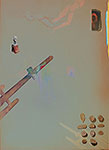Other Studio Pages:
2004 (Aug-Dec) | 2005 (Jan-May) | 2005 (May-Aug| 2005 (Aug-Dec) | 2006 (Jan-Apr) | 2006 (May-Dec) |
2007 (Jan-Aug) | 2007 (Aug-Dec) | 2008 | 2009 | 2010 | 2011-2012 | 2013 | 2014-16 | 2017 | 2018 | 2019
2010
6/19
I've decided to note my situation today, but I don't know if I will resume this log with any regularity. There are three pieces on my easels now. It's as though the winds are light and variable; there is no definite direction. For the previous several months, my work had been moving on with a purpose. Not that I knew exactly what each piece would do, but I sensed a direction that I was exploring.
Not any more. The one piece that has this sense, has it only in one corner.
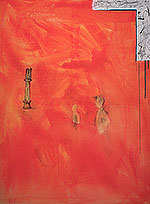 There, my first thought was a totally dark right angle in the upper right corner. When that didn't work out, even though I did a total turn-around, making a white corner with charcoal gestures on it. That new take on the corner was still in the same direction; just a different inflection. The rest of the piece however, is strange. For the third time, I have laid down a red to yellow dynamic wash. The first work was awkward anyway, and my need to do this wash fit in. The second piece, I obliterated the wash in later stages. Now, it appears again. It does not give me a thrill or sense of direction, like the corner did. But I seem to need to work something out here.
There, my first thought was a totally dark right angle in the upper right corner. When that didn't work out, even though I did a total turn-around, making a white corner with charcoal gestures on it. That new take on the corner was still in the same direction; just a different inflection. The rest of the piece however, is strange. For the third time, I have laid down a red to yellow dynamic wash. The first work was awkward anyway, and my need to do this wash fit in. The second piece, I obliterated the wash in later stages. Now, it appears again. It does not give me a thrill or sense of direction, like the corner did. But I seem to need to work something out here.
The same with the other two pieces. For one, I have no feeling for where it wants to go: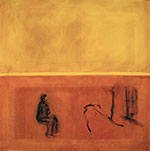
The other one is finished, but I don't know if I want to take anything of it it to another piece: 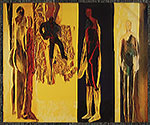 For Bathers at the River, I joined Matisse's Bathers with a painting I had done in 1976, responding to Matisse, and then worked into that with some of my present thoughts about flux and order. Around the outside, I've painted "THIS IS NOT A PAINTING," in the style of Jasper Johns, whom I think also wrestles with the momentary and the lasting, the emotional and the wise. This work has even deeper currents.
For Bathers at the River, I joined Matisse's Bathers with a painting I had done in 1976, responding to Matisse, and then worked into that with some of my present thoughts about flux and order. Around the outside, I've painted "THIS IS NOT A PAINTING," in the style of Jasper Johns, whom I think also wrestles with the momentary and the lasting, the emotional and the wise. This work has even deeper currents.
I am at home with this eddying part of the creative process, and will let it pay out for a while. If the aimlessness turns into frittering, I will demand a focus of myself.
6/23
Finished Memento--Mort, archival computer print, 12x16 in. Before a memorial service for a friend today, I pulled together several pieces that I had been working on, as a Memento Mori. It moved through stages of calendar-like pixelation, to more life-jazz, then an open window (curiosity), and, finally, to a glowing window, moments of passing and meeting legs, and a figure. There are many things I don't know about in this piece, but that is fine.
6/29
"What If I Leave Here Tomorrow" is the working title of the pastel and acrylic I'm working on, with a certain emptiness. The emptiness is not necessarily an emotional one, but rather a sense of the fleeting. The original pastel was of my childhood home, me throwing a ball against the front steps, mom in the back yard, and someone inside, looking out.
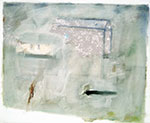  After I had done work on it this morning, I picked up Boorstin, and picked up his take on Montaigne. Montaigne's words struck me: "I do not portray being: I portray passing."
 After I had done work on it this morning, I picked up Boorstin, and picked up his take on Montaigne. Montaigne's words struck me: "I do not portray being: I portray passing."
7/1/2010 
Finished The River, strengthening a bit its notation of the face in Matisse's The Piano Lesson, and the river. 
Also hid the cause of the shadow in What If I Leave Here Tomorrow, and consider it finished.
Although I'm still in the eddies, I sense getting pulled back into the current of...the current. The contrast of what appears to be with what it's connected to or might have been or will become is pulling me back, although the recent different styles and iconography have not coalesced into something consistent and recognizable.
7/13/2010
Working on 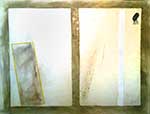 Diptych Plus, 16 x 20, and started
Diptych Plus, 16 x 20, and started 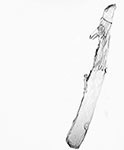 Remnants of the Hours, a 30 x 24 painting, with a drawing of a piece of wood that attracted me. I had used the charred wood as charcoal for The River, and as I set the new canvas on the easel, I saw the wood drawn in the position I put it on the canvas. The actual drawing was pleasurable. I wonder where the piece will go.
Remnants of the Hours, a 30 x 24 painting, with a drawing of a piece of wood that attracted me. I had used the charred wood as charcoal for The River, and as I set the new canvas on the easel, I saw the wood drawn in the position I put it on the canvas. The actual drawing was pleasurable. I wonder where the piece will go.
7/17 Did two pieces on site, in the woods around here. 
Tree Trunk and Fallen Branches, 9 x 12, pencil on paper interested me for the beautiful dynamics: branches flowing and heavy trunk restraining, flow and peace, yin and yang of space and objects. 
One Essence (fallen branches), 9 X 12, watercolor pencil on paper, is an abstract, looking at the essence of what was in front of me in one way. It shows how important is the negative space in the naturalistic drawing. To get this essence, I had to put something in the two dimensional space of this piece that the three dimensional suggestion of the first drawing did not need because of the way our mind works
7/24  Finished Long and Winding Road, 7.5 x 5 in, colored ink and pencil on paper. Enjoyed going over the computer print with pencil, adding connections and obscuring other parts.
8/24 Started Coursings Lattice by overpainting Coursings (6/18/2008). Just an idea that emerged as I was doing paintings in my head. I am wondering and excited about where it will go.
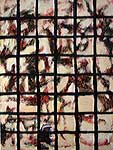 Coursings Lattice, 48x36 in
Coursings Lattice, 48x36 in
9/10 
Completed Survey, ink on paper, 22 x 28 in. It is a survey--of time, of nature/culture, of life/death, of me, and I don't know what else, or even if it is what I think it is.
10/3  
Really Seeing, archival computer print, 12x15 in. This piece began when several friends responded to Survey (ink on paper, 22x28 in., 9/10/2010). Because one person noted how many chairs appeared in my works and how many tonalities those chairs had, I put in an eye chart of chairs. Another friend went on with Yungian interpretations, so, in went Yung and Freud. My initial inspiration was to have the feeling of harmony rising above, much as Saint-Exupery experienced the melding of technology, nature, and human spirit in his Wind, Sand, and Stars. Across the way, the muse looked at it all through her camera.
Then, I started bringing in other things that might set up an interesting and questioning dialog, along the lines of Montaigne's "Essays" ("Tries"). In the several-day flurry of things coming in and out, changing color and position and scale, I am not certain of the exact sequence, but I do know some things. Anyway, the artwork actually exists in "the space between the viewer and the art." as has been said.
The rocks came in, beginning a slow-motion avalanche of placement, as something for the muse to shoot through, the 100-million-year fossils of long-ago life, which may or may not have known connection (thus the gap between them). I got the idea as I was walking on the beach one morning.
Shadows cast by a window on a floor became the ground of the piece, because, one, that is what living and knowing is about for me, and, two, they provided an upsetting, not-so-neat composition, in contrast to the circular and "x" scheme that was developing. I saw the shadows as I was browsing the web, the night that I found the rocks. I juiced up the sun colors that were in the original. Apollo. But, even Apollonian efforts don't get the understanding totally right, especially those that rely only on knowledge that does not contain an understanding of physical and cultural evolution.
I joined two of my drawings in the upper right. I was flipping through drawings to bring my touch, physical and mental, into the work. A drawing of an empty studio (pencil, 12x9 in., 1990's) and a man in motion (charcoal, 24s18 in.,1970's) fit my idea of entering the unknown, rising above Jung, Freud, and positions, especially after I skewed the drawing, adding another dimension to the piece and the thoughts. Much work, getting the studio different yet belonging to the piece, definite yet vague--in general, being "right."
On the beach, another morning, I saw my shadow, and the idea for a shadow (hello, Plato's cave), on shifting sand no less, to represent our thoughts seemed very good. Into the piece it went.
It was when all the above had found their way in that I put the piece on FaceBook, asking whether it seemed finished. I was happy with it, feeling that it was probably finished. So were most people who saw it. Those who didn't think it was finished fell into two groups. Those that were bothered by the gap in the rocks, to which I thought, "good, it's working." The second group was bothered by the eye chart of the chairs, and there again, I thought "good, it's working" (our need to pin down positions, often based on incomplete knowledge is a key element). But, the eye chart continued to bother me. As I made it less obvious, the idea still stood, got stronger separated from the reference to a physical eye chart. That led to color changes in the chair, which made ol' Freud and Yung need some work, and then the empty studio needed to be brought in sync, a chair from a previous work added to the blood and thought of the piece, the muse got a bit less colorful--and other stuff.
I learned again, "probably finished" is not good enough. I experienced, again, that an artwork better have a strong focus by the artist, which will then be seen differently by each viewer. What remains constant is the word "strong" and the Form of the work.
12/7/2010 
As I was gathering ideas for a work to accompany Gabriella Boros' piece celebrating stones, I suddenly found myself grabbing one and throwing it onto the computer. A day later, Stone and Memories was finished.
The ground came most easily. The stones were the merging of a drawing, a watercolor, and part of an acrylic. The lower easel was hard, needing to be both plasma-like and solid. The philosopher and book just moved around and tried out various scaling. The female figure, from a painting, tried out various incarnations until an accident suggested both reclining and moving off. Upper right face came in late, for balance, visual and human. The shadow of the easel, a key fulcrum between the thought of the philosopher and the insistent existence of the stones, came fairly easily after triple-layering.
I think the piece captures how I feel and think about all reality.
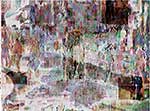
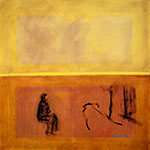
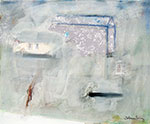
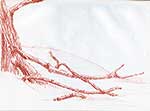 Tree Trunk and Fallen Branches, 9 x 12, pencil on paper
Tree Trunk and Fallen Branches, 9 x 12, pencil on paper _sm.jpg) One Essence (fallen branches)9 X 12, watercolor pencil on paper
One Essence (fallen branches)9 X 12, watercolor pencil on paper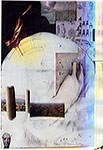
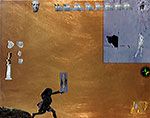 Survey, ink on paper, 22 x 28 in
Survey, ink on paper, 22 x 28 in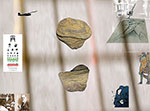 Really Seeing [early version]
Really Seeing [early version]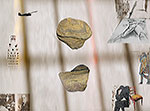 Really Seeing, archival computer print, 12x15 in.
Really Seeing, archival computer print, 12x15 in. 